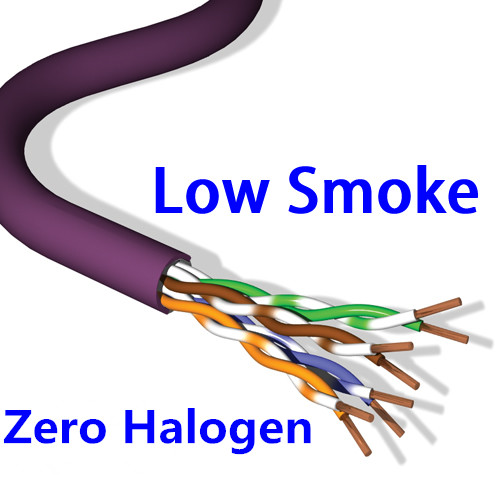Nowadays, “Green consciousness” is a trend that is being embraced globally to protect the environment. Under this circumstance, Low Smoke Zero Halogen (LSZH) cable enjoys its increasing popularity among users. LSZH cables are flame retardant and most importantly do not generate toxic gas. Furthermore, the increasing regulations at the local, state and government levels regarding flame and smoke requirements have led to the use of LSZH cables. But what makes LSZH so special in the telecommunication industry, read this article and you will get the answer.
What Are Halogens?
When grouped together, the elements fluorine, chlorine, bromine, iodine and astatine make up a chemical family known as the Halogens. You may not have been aware of it, but halogens have many applications, and most of us come into contact with them on a daily basis. Just think of it: the fluoride in your toothpaste, the chlorine in your pool, the iodine in your medicine cabinet, etc. They’re all halogens!
When grouped together, the elements fluorine, chlorine, bromine, iodine and astatine make up a chemical family known as the Halogens. You may not have been aware of it, but halogens have many applications, and most of us come into contact with them on a daily basis. Just think of it: the fluoride in your toothpaste, the chlorine in your pool, the iodine in your medicine cabinet, etc. They’re all halogens!
What Is LSZH Cable?
Low Smoke Zero Halogen cable, short for LSZH cable, is a type of cable. The jackets of LSZH cable consist of thermoplastic or thermoset compounds that produce limited smoke and no halogen when come across high sources of heat. LSZH cable can be also called LSF (low smoke and fume), LSHF (low smoke halogen free), and LSOH (low smoke zero halogen) cable. The following figure shows a LSZH fiber patch cable.
Low Smoke Zero Halogen cable, short for LSZH cable, is a type of cable. The jackets of LSZH cable consist of thermoplastic or thermoset compounds that produce limited smoke and no halogen when come across high sources of heat. LSZH cable can be also called LSF (low smoke and fume), LSHF (low smoke halogen free), and LSOH (low smoke zero halogen) cable. The following figure shows a LSZH fiber patch cable.

Low Smoke Zero Halogen Cable: a Safer Alternative
The most obvious advantage of LSZH cable is that It reduces the amount of toxic and corrosive gas emitted during combustion. This type of material (such as polypropylene) contains absolutely no halogens, but still has excellent flame resistance and produces very little smoke when burned. This material is typically used in badly ventilated areas such as planes or railroad cars. The cable jacket for these wires is designed to minimize the release of halogen fumes and toxicants into the air, reducing the potential of hazardous contact in occupied spaces. LSZH cables are for utilization in patching environments with poor air circulation where personnel and equipment may be exposed to corrosive fumes and toxins during combustion.
The most obvious advantage of LSZH cable is that It reduces the amount of toxic and corrosive gas emitted during combustion. This type of material (such as polypropylene) contains absolutely no halogens, but still has excellent flame resistance and produces very little smoke when burned. This material is typically used in badly ventilated areas such as planes or railroad cars. The cable jacket for these wires is designed to minimize the release of halogen fumes and toxicants into the air, reducing the potential of hazardous contact in occupied spaces. LSZH cables are for utilization in patching environments with poor air circulation where personnel and equipment may be exposed to corrosive fumes and toxins during combustion.
In addition, LSZH cabling is the safest choice for plenum use and any other applications in which smoke is likely to both build up and come into contact with people, since no harmful toxins are actually released. Low Smoke Zero Halogen cable also has the added benefit of complying with the European Union’s Restriction of Hazardous Substances (RoHS) directive and similar North American safety and environmental standards.
Application
LSZH cable reduces the amount of toxic and corrosive gas emitted during combustion. This type of material is typically used in poorly ventilated areas such as aircraft, rail cars or ships. It is also used extensively in the railroad industry, wherever high voltage or track signal wires must be run into and through underground tunnel systems. This reduces the chance of toxic gasses accumulating in these areas should the wires be damaged by fire or a short circuit fault.
LSZH cable reduces the amount of toxic and corrosive gas emitted during combustion. This type of material is typically used in poorly ventilated areas such as aircraft, rail cars or ships. It is also used extensively in the railroad industry, wherever high voltage or track signal wires must be run into and through underground tunnel systems. This reduces the chance of toxic gasses accumulating in these areas should the wires be damaged by fire or a short circuit fault.
Summary
This article explains a little about what LSZH cables are, their advantage, and the application that it’s safer and healthier to go halogen-free in. Fiberstore supplies PVC/LSZH fiber patch cables terminated with LC/SC/ST/FC/MTRJ/MU/SMA connectors on both ends. And All LSZH fiber patch cables in Fiberstore can be customized according to your specific requirement. For more information about LSZH fiber patch cable, please see: www.fiber-optic-solutions.com.
This article explains a little about what LSZH cables are, their advantage, and the application that it’s safer and healthier to go halogen-free in. Fiberstore supplies PVC/LSZH fiber patch cables terminated with LC/SC/ST/FC/MTRJ/MU/SMA connectors on both ends. And All LSZH fiber patch cables in Fiberstore can be customized according to your specific requirement. For more information about LSZH fiber patch cable, please see: www.fiber-optic-solutions.com.

No comments:
Post a Comment